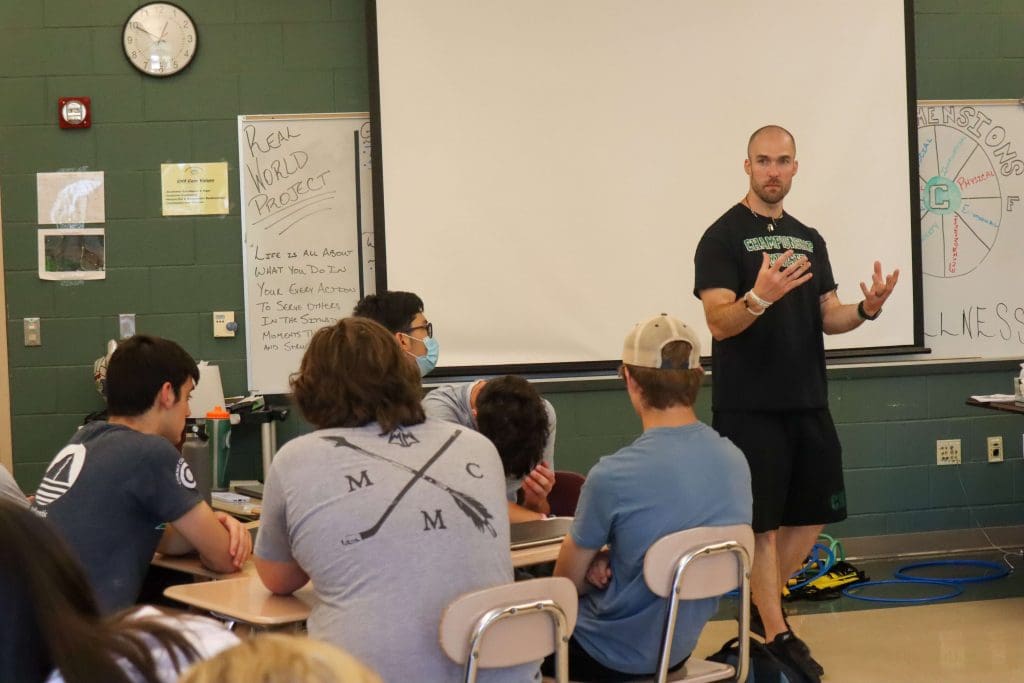The landscape of physical education has evolved significantly over the last decade and it is critical that PE teachers adapt accordingly. In order to move the profession forward and cater to student needs, we must constantly assess our curriculum and explore new pedagogies, curricula, and technology. Curriculum mapping offers teachers and schools opportunities to think big picture, explore best practices, and improve the learning process for students.
The purpose of this article is to assist PE teachers in exploring standards-based curriculum design that emphasizes a student-centered learning environment. This entails teaching fundamental prerequisites and implementing an elective model that enhances student participation by offering a more comprehensive range of choices.
Why The Curriculum Mapping Process Matters
Sadly, 49% of teenagers today are considered overweight. This increases their risk of suffering from a variety of preventable diseases, including heart disease – the #1 cause of death in the United States.
Coincidentally, the same percentage of students do not attend weekly PE class, and less than a quarter of kids meet the CDC guidelines for 60 minutes of activity a day.
Not only is physical wellness on the decline, we are also seeing an increase in mental illness a, declining academic performance, and troublesome classroom behavior issues.
While it isn’t a panacea, physical activity and exercise have been shown to positively influence ALL of these troubling trends. It is for this reason, schools must reinvest in the physical education subject area, while at the same time, PE teachers must ensure that their curriculum is teaching students how to live healthier, more active lifestyles.
To do so effectively, we must help students find their passion for activity an exercise, which means expanding our curriculum beyond the traditional “games” model. With that call to action, let’s dive into curriculum mapping for physical education.
Backward Design of Curriculum Mapping
When starting a curriculum plan, the “Understanding by Design” framework, created by Grant Wiggins and Jay McTighe, is a great place to start. It is a tool for educational planning focused on teaching for understanding, using “backward design” – the practice of looking at desired outcomes in order to design performance assessments, curriculum units, and classroom instruction.
When using this curriculum mapping framework to create a vertically integrated PE Curriculum, that means starting with high school students and your upper grade levels. Surveying these students to understand the types of classes they want to take as electives will help inform your curriculum choices in earlier grade levels.
In a recent national united states survey, the two most requested classes were weight training and Yoga. Also popular were alternative Lifetime Fitness courses like HITT Bootcamps, Dance and Boxing, along with Recreational Activities like Spikeball, Pickleball, and Kan-Jam.
We will use this as our sample framework moving forward in this article, but the practice of matching curriculum to survey responses can be adapted across units.
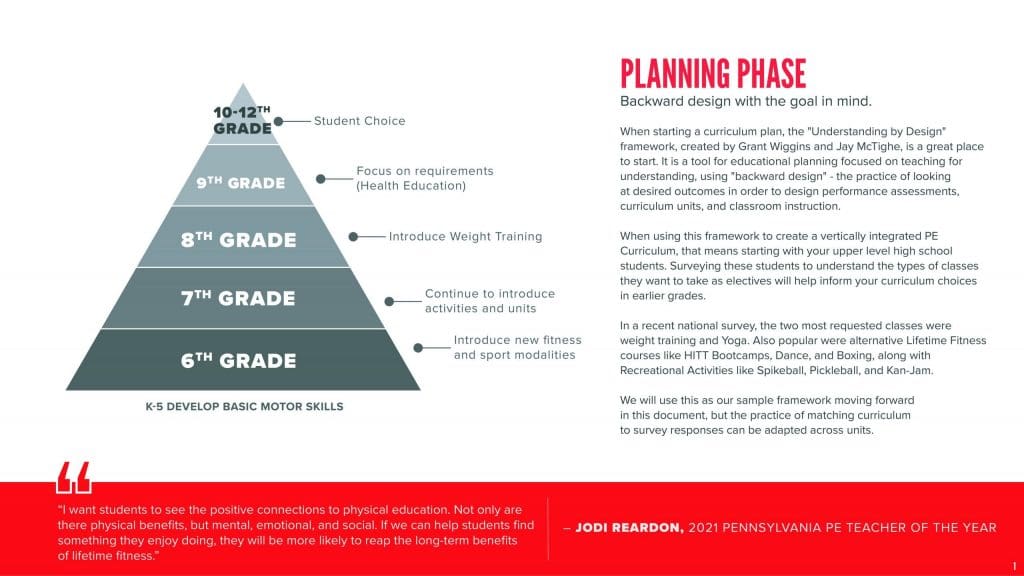
Vertically Aligned Secondary PE Model
Vertically Aligning Physical Education means that no building, class, or teacher operates in a silo. Instead, everything that is done within PE at each grade-level fits in as one piece in the larger puzzle. By aligning scope and sequence throughout the district we can avoid unwanted repetition, ensure full standard alignment, and create a more student-centric approach.
The 10,000 Foot View of Curriculum Mapping:
Create a common foundation of motor skills in middle school
Create a student-centered learning environment at the high school with engaging electives
Address important health and wellness concepts throughout students time in PE
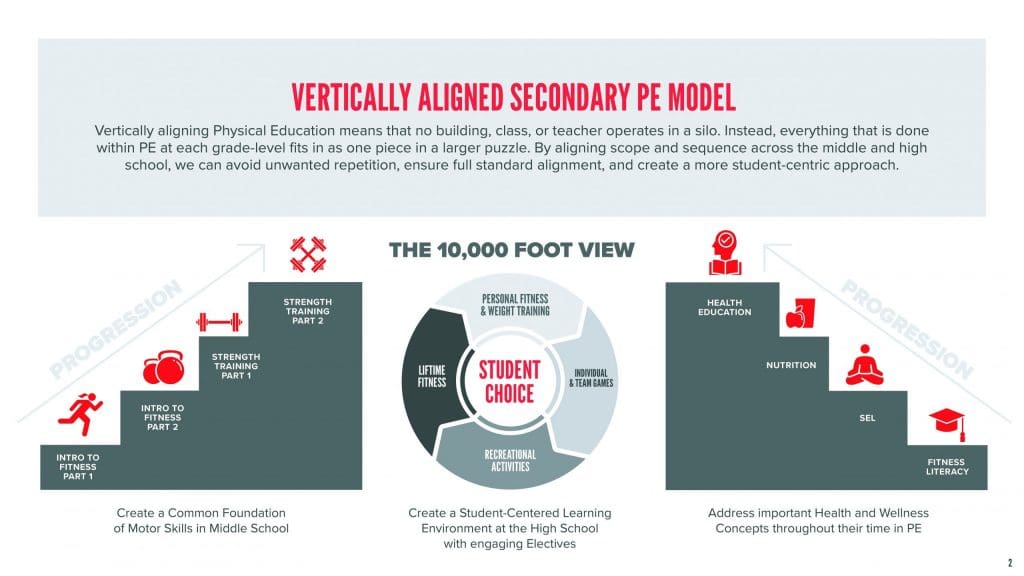
Factor in Standards and Desired Outcomes
Once we know what type of elective students want at the high school level, we can begin to lay the groundwork for preparing kids with the required cognitive and physical know-how to pursue these elective courses. This means beginning to plan from the middle school level, with the high school courses in mind.
To help with this step, we can look at the national standards for physical education and associated student learning outcomes.
- Standard 1: The physically literate individual demonstrates competency in a variety of motor skills and movement patterns.
- Desired Outcome: Students become proficient in the basic human movements: Squat, hip hinge, lunge, press, pull, walk/run.
- Standard 2: The physically literate individual applies knowledge of concepts, principles, strategies and tactics related to movement and performance.
- Desired Outcome: Students improve their motor skills and movement patterns, and apply them in a recreational setting.
- Standard 3: The physically literate individual demonstrates the knowledge and skills to achieve and maintain a health-enhancing level of physical activity and fitness.
- Desired Outcome: Students understand the basics of nutrition and healthy eating, while mastering the foundational movements.
- Standard 4: The physically literate individual exhibits responsible personal and social behavior that respects self and others.
- Desired Outcome: Students learn to work well with others by operating in group based activity.
- Standard 5: The physically literate individual recognizes the value of physical activity for health, enjoyment, challenge, self-expression and/or social interaction.
- Desired Outcome: Student survey responses indicate favorable feelings toward exercise and activity, and the ability to identify their favorites.
Curriculum Mapping Playbook!
Discover successful strategies for vertically aligning your PE curriculum and providing a more engaging experience for students!
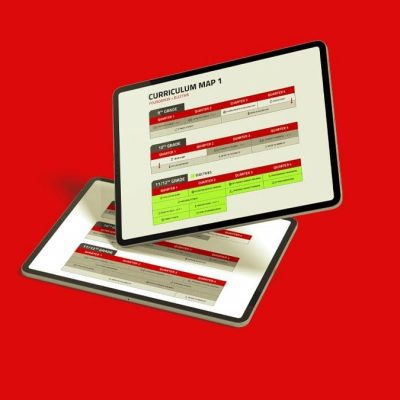
Graded Based Curriculum Maps
Below are 5 completed curriculum map templates for middle and high school. While these maps still take a big picture view, we have also embedded sample course content and programs from the PLT4M library.
If you want to take a deeper dive into any of the instructional materials referenced throughout this curriculum mapping article, please reach out to PLT4M for more information and program information!
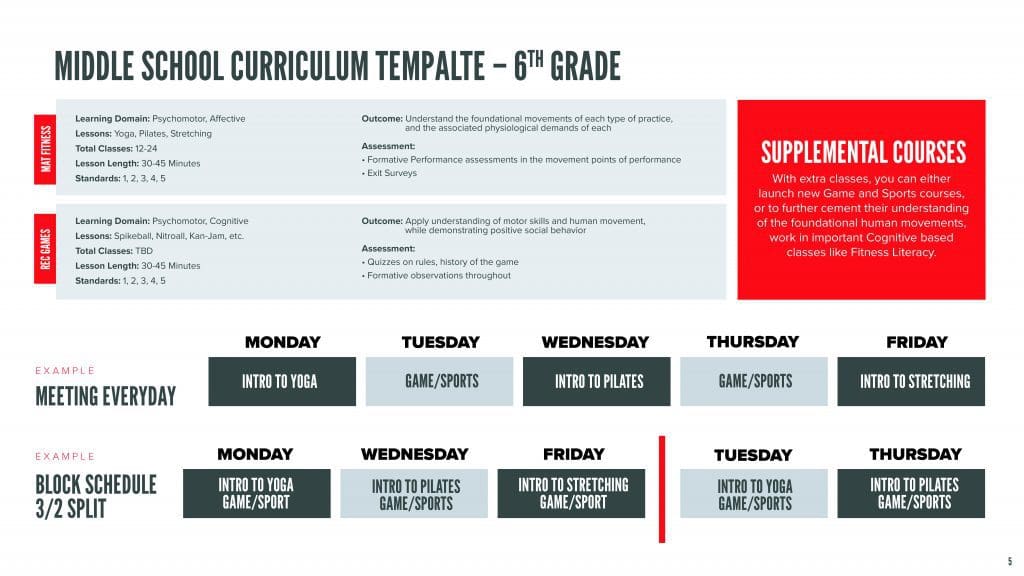
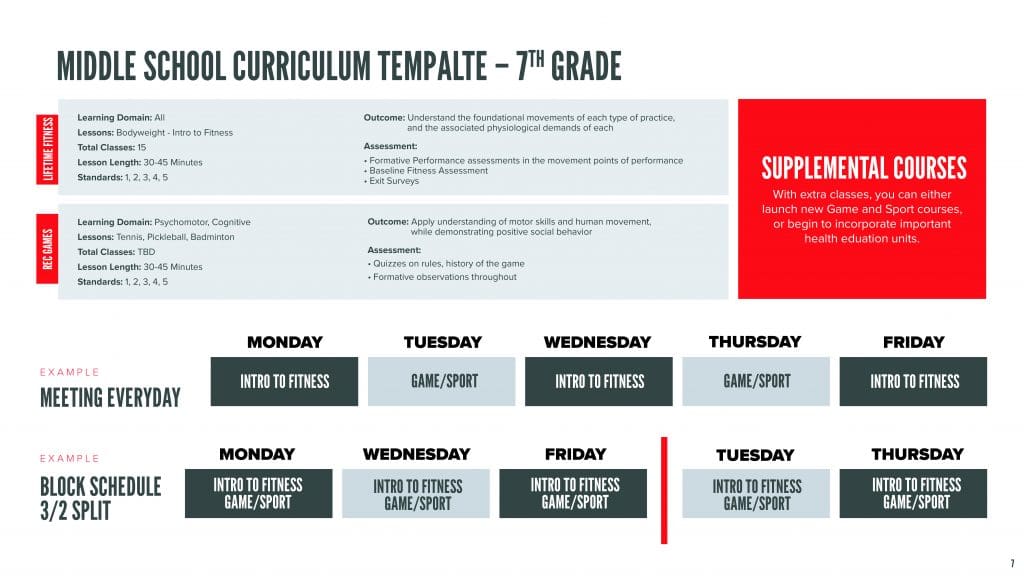
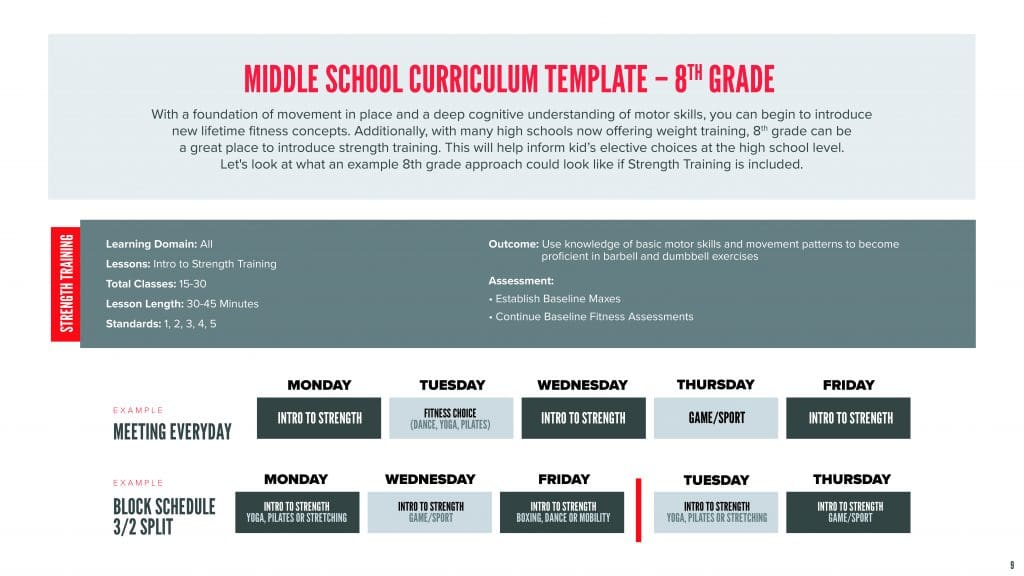
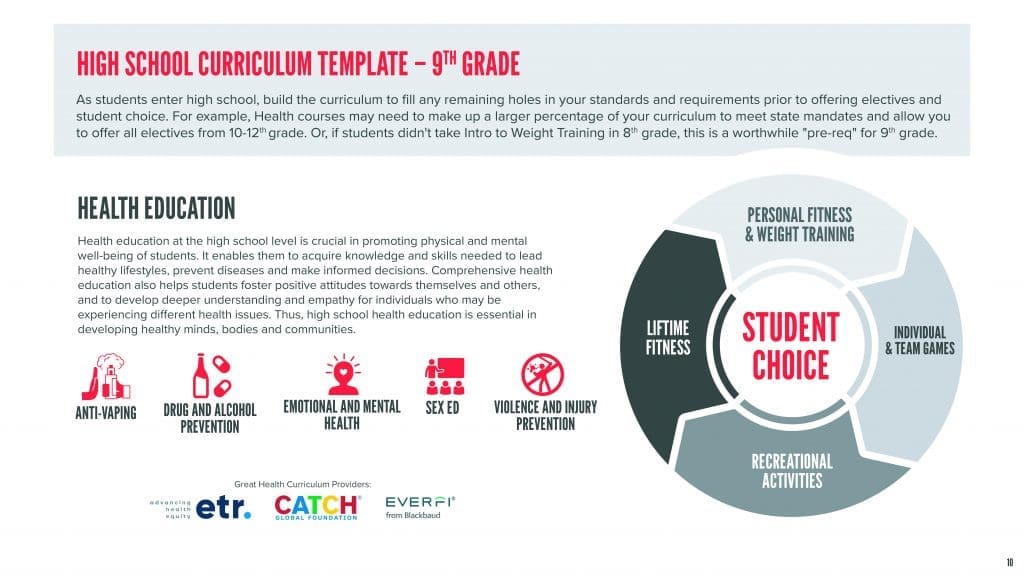
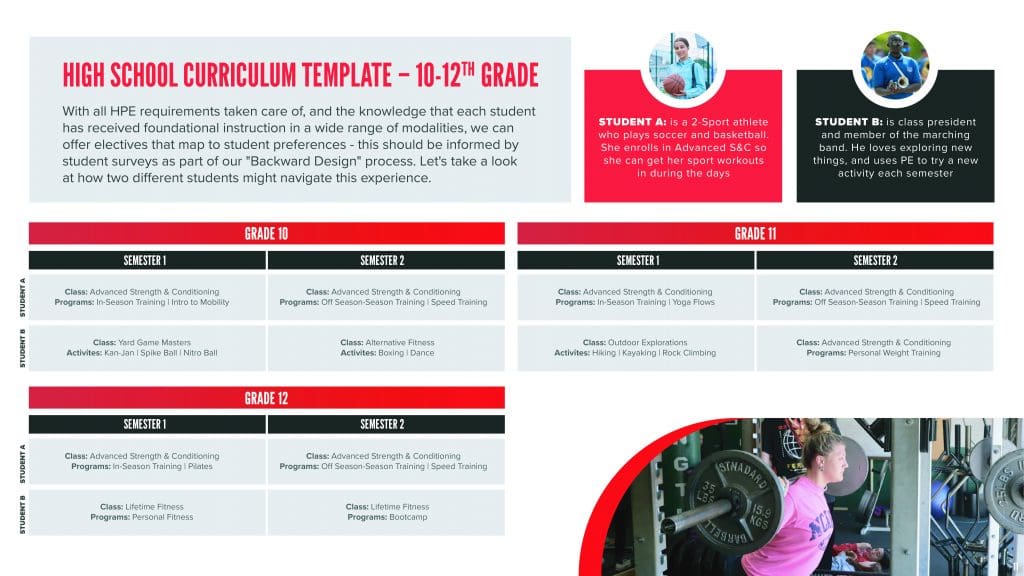
Sample Lesson Plans
Within the curriculum mapping examples above, there are references to different PLT4M lessons. If you want to check out more sample lesson plans and how they can help with your curriculum mapping, check out some other helpful links:
As an added bonus, check out a few follow lessons from our library includedin the sample curriculum mapping templates below:
Sample Lesson - Intro To Fitness
Today, we are beginning our movement and fitness journey by learning two of the most important foundational human movements – the Squat & the Hinge.
The Squat is arguably the most foundational movement within any fitness or training program. Why? It’s simple. Mastering it boasts the most bang for your buck. Firstly, it is a movement pattern essential to our DNA. Squatting (properly) is how we were designed to sit – chairs, couches, and toilets haven’t always existed. Squatting and standing is our way of getting up and down. Today we will learn the Air Squat.
We will also be introducing the hip hinge through an exercise called the “Good Morning”. It will set us up for safety during big lifts down the road and help us develop the core strength and stamina necessary for performance and injury prevention. We will “super-set” the good mornings with some elbow planks to begin our core development.
The entire session today is not meant to be grueling. We want great, consistent movement. Focus on technique first, intensity a distance second.
Sample Lesson - Pilates
Welcome to your first PLT4M pilates lesson. Pilates is a low-impact form of exercise that focuses on control while enhancing balance, and flexibility. It provides an excellent challenge to all major muscles groups with a special emphasis on our core!
The core is the powerhouse of our body and you will hear Britney talk about using your powerhouse throughout today’s class. We focus on the core because it helps improve all other movements and exercises.
The focus of today’s class is control. We want to be sure we are controlling our body as we move through space and are being deliberate with our movement.
Whether this is your first-ever pilates class or you have taken some in the past, you are sure to have an awesome time. Let’s go ahead and get started!
In today’s class, the Pilates exercises include:
1) Hundreds
2) Roll Backs
3) Single Leg Circles
4) Rolling Like A Ball
5) Single Leg Pulls
6) Star Stretch
7) Forward Fold
8) Seal
Sample Lesson - Intro To Strength Training
The loaded back squat is relatively simple in it’s execution, so long as you always keep all 4 points of squat performance in mind during every rep.
When squatting with a barbell, though, what we must pay attention to goes well beyond the squat movement pattern itself. How to set up for the lift properly, how to navigate the rack, how to prepare for and execute a failed lift, and so on. These elements may not seem hugely important, especially at the beginning when using little to no weight, but they will be SUPREMELY importnat down the road.
Today our focus is on learning the movement as a whole and practicing with VERY light weight. This is about accumulating experience with a new skill, not trying to move big weights! Watch the video closely, and pay attention to the details. The more we soak up now, the easier things will be in the long run.
Ready to WOW your Admins?
Schedule a 15-Minute demo to learn how PE teachers are ushering in a new age of Physical Education with Fitness and Technology!
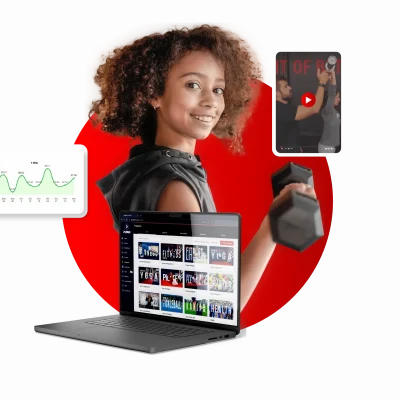
Key Takeaways On Curriculum Mapping for Physical Education
In this article, we have just scratched the surface of curriculum mapping for physical education. And curriculum mapping takes time and planning, especially to achieve continuity across grade levels. But in the right educational environment, physical education teachers and other key stakeholders can work together to create a comprehensive physical education course content offering.
As a result, we can improve the student learning process and instill lifelong fitness, health, and wellness skills for students. In addition, physical education can and should maintain high academic expectations just like any other subject area. But high expectations doesn’t mean we can’t also create fun and engaging lesson plans that will excite and motivate students on a regular basis.
If you want to take a deeper dive into any of the instructional materials referenced throughout this curriculum mapping article, please reach out to PLT4M for more information and program information! Our team of instructional designers and physical education experts are here to help as you set out to reimagine your physical education curriculum mapping process!
